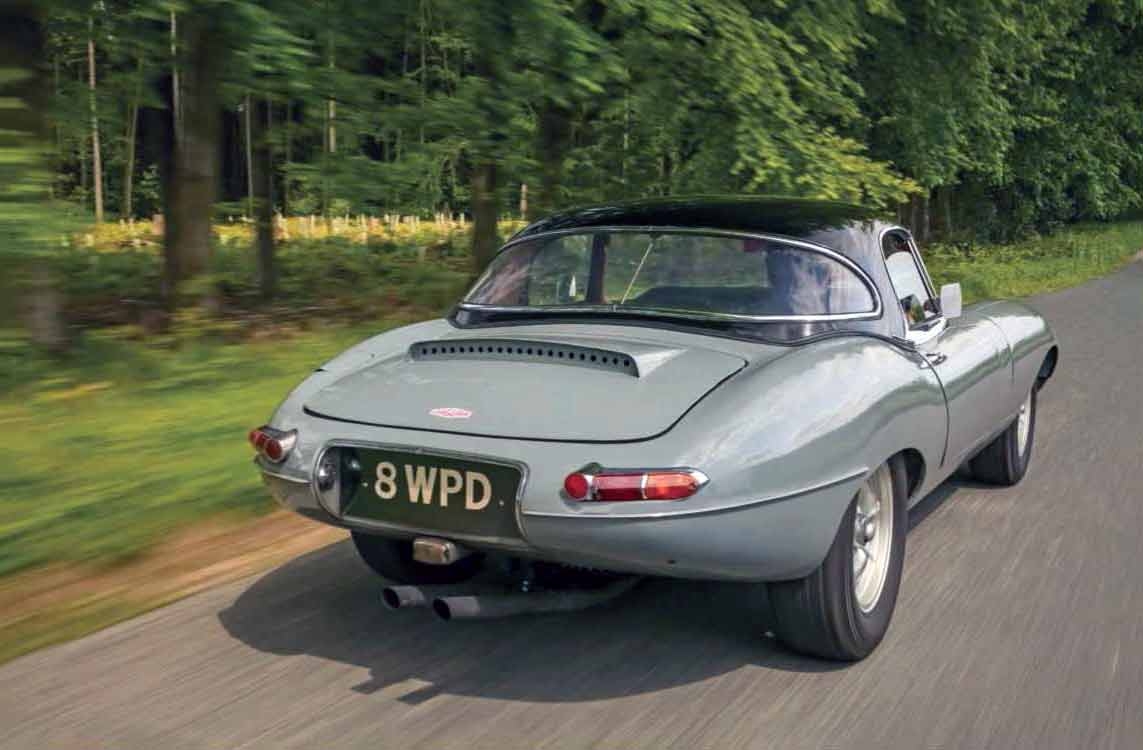
The ultimate E-Type? Mick Walsh is blown away by a unique Jaguar that puts Lightweight spec into a magnificent roadgoing roadster.
THE SPECIAL ONE When a serious Jaguar enthusiast asked for a road-legal Lightweight, Browns Lane made it happen. And this demure-looking E-type doesn’t disappoint Words Mick Walsh. Photography Tony Baker.
LIGHTWEIGHT E-TYPE BUILT FOR THE ROAD
‘Performance through the gears is spectacular, the long nose lifting as the Jaguar punches forward with effortless pace’
Continuation Lightweight E-types hold little appeal for me, but a historic Jaguar that oozes history through the genuine patina of use and long, rewarding ownership is something very special. The understated battleship grey, bumperless E-type pictured here is just such a wonderful machine. Sitting silent outside Camp Hill, an 18th-century house near Kirklington in Yorkshire, this special Jaguar spent its early life in this area. For that reason it had to return to meet the Ropner family members who remember the car when it was new, none more so than octogenarian bobsleigh legend Bruce, the son of the E-type’s distinguished first owner. The joy of a genuine classic car is discovering its history and revisiting those roots. No replica, no matter how exotic, has that fascinating attraction.
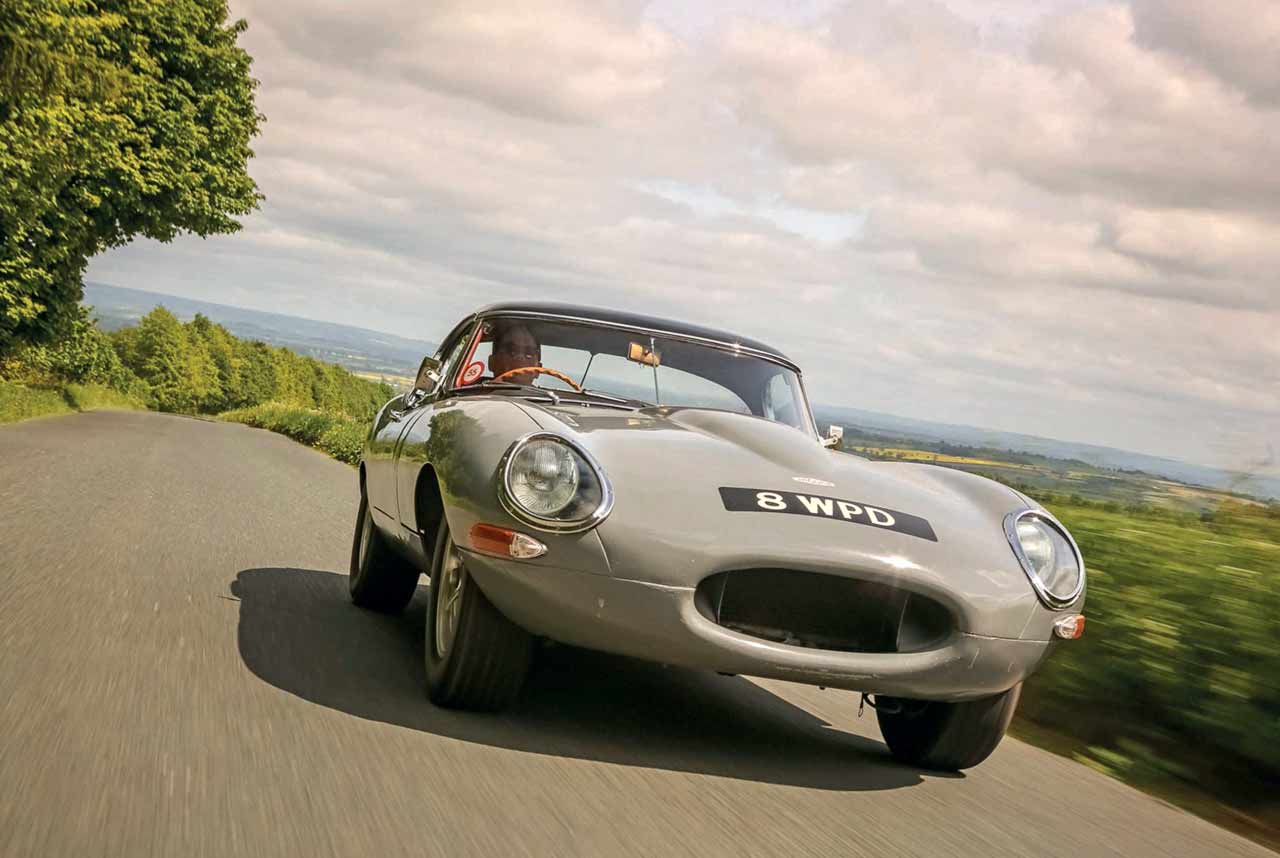
Standing by 84-year-old Ropner as his face lights up on seeing the grey E-type burble in is a special moment. “It was always garaged here with my father’s D-type,” he recalls. “It was a breathtaking road car and my father used it regularly to drive to the office in Darlington. “That was 24 miles each way, and before the speed limit he would see 130mph several times en route. My father also used it to drive to London and regularly street-parked it outside the flat.
In May 1968 the E-type did a fantastic road trip of Europe, visiting Paris, Avignon, Monaco, Lausanne, Frankfurt, Cologne and Brussels. I remember he was frustrated when a brick fell off a French lorry and dented the alloy bonnet.”
As well as exotic jaunts, the E-type was used for local trips with friends. Passengers included a young Susannah Fletcher – better known as the famous film star Susannah York: “My father preferred understated colours for his cars. His previous Aston Martin DB3S coupé was also painted grey with red trim.”
Although Ropner has no hesitation about climbing aboard a bobsleigh aged 84, he’s apprehensive about driving the now-valuable E-type, but is happy to ride with specialist David Brazell at the wheel, for a memorable trip around familiar local roads. On his return, Ropner’s smile is wider than ever: “It still feels very quick. Please can you take my son out for a run?”
Known as the ‘bionic man’, Ropner has new hips and knees, but is still a hugely motivated chap who continues to raise funds for bobsleigh sport. The ‘Ropner E-type’, as it’s known to Jaguar historians, has been re-registered, repainted and rebuilt over the past 45 years, but remains a wonderfully genuine car with immense character and spectacular performance. The parallels between the two British legends seemed obvious. Looking at old photo albums under the dramatic Spanish Chestnut tree that shades the drive at Camp Hill, we are all captivated by the reunion. Watching and listening to Ropner as he remembers his dad’s old E-type is a lovely experience: “We used to call the tree ‘the garage’, because father always parked his cars under it.”
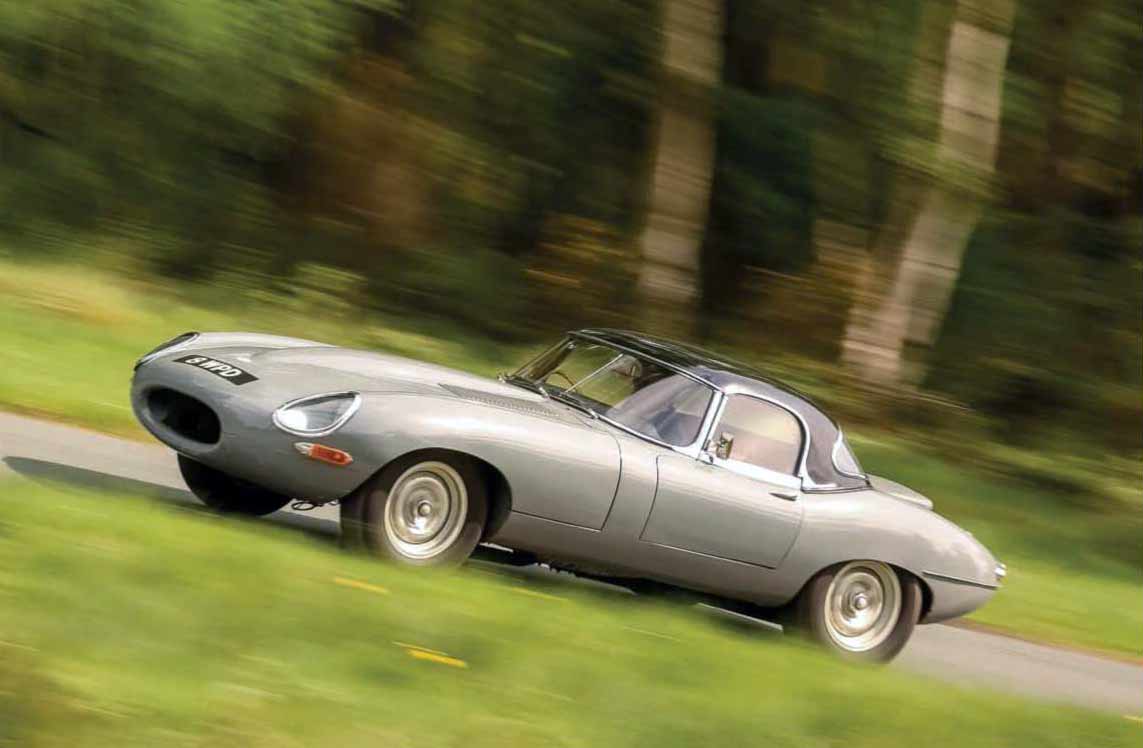
The Jaguar looks so right back on the Yorkshire driveway but, after hearing the stories, I am mad keen to drive it. Sorted E-types, particularly unrestored examples, never cease to impress me, and I can’t imagine how these cars must have felt in the early ’60s, particularly this specialorder ‘racer for the road’.
Pull open the door and its light weight instantly indicates that this is no ordinary ‘flatfloor’ E-type. Settle into the well-worn red leather bucket seat, and a quick review of the cabin reveals distinctive details including a round metal plate on the wide transmission tunnel, indicating the desirable ZF gearbox. Fixed by the glovebox opening is a dealer plaque for Glovers of Ripon. Holding the original, wood-rimmed steering wheel and glancing at the 160mph speedometer, I imagine how many times the revs have been stretched to achieve peak performance. All of Ropner’s memories suddenly became more vivid as the straight-six idles, and it is a strange feeling heading down the Camp Hill drive where it arrived new in 1964, and will probably never return.
Out on the road, the car’s charm is even more rewarding. The five-speed ’box feels notchy until fully warmed, but the ratios are closer and the action faster through the stubby, alloy-topped lever. We motor east to Thirsk in search of quieter, open roads to better appreciate the E-type’s alluring character. Jaguar’s chief engineer Bill Heynes was right to advise that the bespoke order be based on a steel monocoque, because the interior is refined and the tuned engine less intrusive. The interior doesn’t cook, even in traffic on a hot day, and over bumps there are none of the rattles of the racer.
Finally, the route clears on the A170 across Scawton Moor and this great Jaguar gets a chance to stretch its legs. The performance through the gears is spectacular, that signature Malcolm Sayer-designed nose lifting as it punches forward with effortless pace. Best of all is the sharp roar that accompanies the charge. Powering out of the hairpins climbing Sutton Bank, it happily gives a superbike a challenge, but through the open bends near Wass the car shows its true pedigree. The handling, steering and brakes are superb, yet it’s the urgent torque and smooth power that make it all so rewarding. The mid-range punch is addictive, and equally impressive is how the car copes with bumps as you storm out of rougher corners.
The history of the 12 original, factory-built Lightweight racers is well known, but in 1963 a wealthy baronet and Jaguar lover, Sir Robert Ropner, contacted the Browns Lane works about ordering a Lightweight for road use.
With a fortune made by his father in the shipping business, the 55-year-old Ropner had the resources to indulge in fast cars. Through his acquisition of a new D-type, XKD 514 – bought primarily for road use – along with a hot Mk2 saloon, Ropner was a valued customer of Jaguar, so his enquiry about a Lightweight was given special attention. Even Heynes became involved in the detailed specification of this one-off E-type.
When said enquiry via Glovers found its way to Heynes’ desk, special consideration was made to tailor the bespoke road car to Ropner’s needs. Heynes appreciated that the full race-spec, aluminium racer would be an impractical, noisy and challenging machine to use regularly on the road, so details of this unique car were adjusted to make it stronger and more refined, while at the same time fulfilling the ultimate performance requirements. The Kirklington-based baronet would expect nothing less than the fastest roadgoing Jaguar, and later corresponded directly with the factory over various concerns.
Heynes instructed that chassis S850817 be built around a steel-skinned monocoque with an aluminium bonnet and door skins, but with steel frames to support standard window glass. The engine was also a compromise for road use with a cast-iron block, a wet sump and a race-bred 35/40 wide-angle cylinder head. Internally, the straight-six had a polished and balanced crankshaft and conrods matched to a lightened flywheel, as well as high-lift camshafts. Triple Weber DC03 twin-choke carburettors, as fitted to the D-type, produced around 280bhp at 5500rpm, but what gave the E-type its performance legs was a five-speed ZF gearbox.
Another notable feature is the 3.54:1 back axle with a Thornton Tork-Lok limited-slip differential. The front featured a thicker anti-roll bar while the rear suspension, as with the Lightweight racers, incorporated MkX components.
Ropner insisted that his E-type had an understated presence and specified a gunmetal-grey paint finish with a black hardtop and red leather trim. However, to keep the weight down, neither front nor rear bumpers were fitted. To complete the purposeful look, Dunlop alloy disc wheels were ordered to take the extra power.
With a potential top speed of over 165mph, Jaguar and Dunlop were worried about the RS5 and SP tyres, and advised Ropner to avoid prolonged runs at 130mph. High-speed testing on the German autobahn had caused concerns at the factory, and Heynes was fully aware that Ropner had plans to take the car abroad. Even Jaguar chassis engineer Derrick White became involved in the specification, advising Ropner to retain the 3.54 axle ratio until the engine was run in, before a higher 3.31 was ordered. Heynes clearly became familiar with the baronet because later correspondence is simply signed ‘Bill’.
This spectacular E-type was finally finished in May 1964 and Ropner went to Browns Lane to collect it, with the distinctive registration number 1 WW. Heynes himself turned out to greet his esteemed client, before Ropner drove 1 WW home. The ‘Semi-Lightweight’ proved to be sensationally fast and was taken on various high-speed trips to the Riviera.
Even on the Continent little could match the grey E-type’s acceleration and Ropner never spared the horses. And as well as glamorous lady friends, passengers included Ropner’s corgi dogs. Further correspondence with Heynes reveals continued frustrations with ‘spitting’ above 5000rpm, which, as he complained: ‘Utterly does away with the pleasure one gets on occasionally having an open road.’
The report irked Heynes, who’d had reservations about the fitment of Webers in the first place. The set-up required specialist tuning and Heynes concluded that Ropner might be better to fit SUs while further Weber development progressed. Ropner’s irritations continued, as a letter states: ‘The whole thing has gone on for long enough. The car is in all other ways so delightful it is a shame to have it spoilt by such a stain on its character.’
Historic racer and car connoisseur Neil Corner vividly recalls a surprise encounter with 1 WW when driving back from Silverstone on a Monday morning, en route to Durham: “I was cruising up the old A1 at about 90mph in my DB4 and somewhere near Catterick I suddenly saw in the rear-view mirror this E-type approaching fast. I wasn’t paying much attention and put my foot down. The E-type edged past me doing about 120mph – there was no speed limit then – and I noted a puff of smoke from the exhaust as it accelerated ahead. I remember turning to Freda [his wife] and saying ‘it must have a five speed ’box’.” When the two sports cars reached Scotch Corner, the drivers pulled over: “It was Robert Ropner, who I had on occasion seen driving his D-type near Darlington. We had a good chat before motoring on.”
Corner later owned the ex-Dick Wilkins Lightweight no 11, for which he traded a Lamborghini Miura in 1970 – “the Miura was the worst car I ever owned” – and in the ’80s he finally got a drive of the Semi-Lightweight. “I’d become good friends with [later owner] John Foster, and on one fishing trip to Glenshee he invited me to have a drive. I had a fabulous run on the A93 across Deeside. Unlike our noisy Lightweight, the Ropner car was an ideal road car, both comfortable and fast. I’ve recently acquired a 3.8 fhc and a 4.2 roadster, which are fantastic value. I can’t understand why it’s taken me so long to discover what great cars they are.”
Ropner kept 1 WW for seven years and, as with his D-type, it was regularly called into service for the drive to his office in Stockton-on- Tees, near Darlington. Many motorists would have encountered the distinctive, rapid E-type as the baronet blasted by on the A1.
Ropner eventually sold 1 WW in 1971 to Alan Ensoll, another northern D-type owner who started racing the E-type in club events at Oulton Park and Snetterton, always driving to circuits in the best clubman tradition.
Ensoll kept the car for two years before it moved through the trade via Martin Johnson and Brian Classic to Michael Fisher. Few knew of the car’s history, but its performance always impressed. Fisher painted it mustard yellow with a black hardtop, and modifiations included fitting one of the works-type vented bootlids.
After racing it a few times, Fisher exchanged it for the Cunningham Lightweight, 5114 WK. At some point it was repainted dark blue and remained in the north until acquired by Foster, the founder of the Ecurie Ecosse Tour.
A passionate Jaguar enthusiast, Foster owned the ex-Peter Walker Le Mans XK120 and a V12 E-type. Desiring something different, he ran an ad in Motor Sport: ‘Good Scottish home available for an older Jaguar with competition history.
WHY? [what have you].’ A Yorkshireman phoned and said he had an ideal swap: the Ropner E-type. Foster shot down to see it and, although it was looking a little tired, he agreed to swap the XK and V12. On arriving home in the new acquisition, his wife was not impressed.
Ever the perfectionist, Foster began a sympathetic restoration, preserving the original interior and rebuilding the unique iron block, which was cast for Ropner using the special aluminium-engine patterns. As with all his Jaguars, Foster drove the Semi-Lightweight extensively on epic Scottish roads, clocking up thousands of memorable miles. At RAF Kinloss on the Moray Firth, he was able to confirm the car’s performance – but at 155mph in fifth, he ran out of runway.
Foster kept the E-type for more than 30 years before selling it to Jonathan Turner in 2012. It returned to the track for the VSCC Pomeroy Trophy that year and enjoyed several test days at Goodwood, but was thought too original to race. At the 2013 London Concours it kept illustrious company, following the ex-Roberto Rossellini Ferrari 375MM and the Le Mans-winning Porsche 917 down The Mall.
After that, this great car was sold to John Currie and it recently joined Lord Bamford’s impressive collection, where it continues to be cared for by specialist Brazell, who has looked after the car for several owners. “I remember seeing the E-type as a boy when it was owned by John Foster and I loved it,” enthuses Brazell, who prepares many legendary Jaguars including the historic Ecurie Ecosse D-type, XKD 603. “For me it’s the best roadgoing E-type, particularly because Bill Heynes had a hand in developing it. It doesn’t quite have the power of a full competition car, but it’s much more usable. I love its understated, slightly shabby-chic appearance that no-one takes seriously at first. I’ve even been asked to bring it to the local fête. This lovely patinated old car must never become a concours trailer queen, but it’s a challenge to talk owners out of repainting it.”
After talking to the Ropner family and enjoying a memorable blast, I couldn’t agree more. Just imagine gunning this wonderful E-type up to the Borders and experiencing its massive performance over deserted Highland roads. Little wonder that Foster kept it for three decades. No doubt this great one-off Jaguar inspired his wonderful Ecurie Ecosse Tour, which many enthusiasts still rate as the best driving event they’ve ever experienced.
Thanks to Bruce Ropner, Lord Bamford and David Brazell
Tech and photos
“I love its understated, slightly shabby-chic appearance that no-one takes seriously at first. I’ve even been asked to bring it to the local fête”
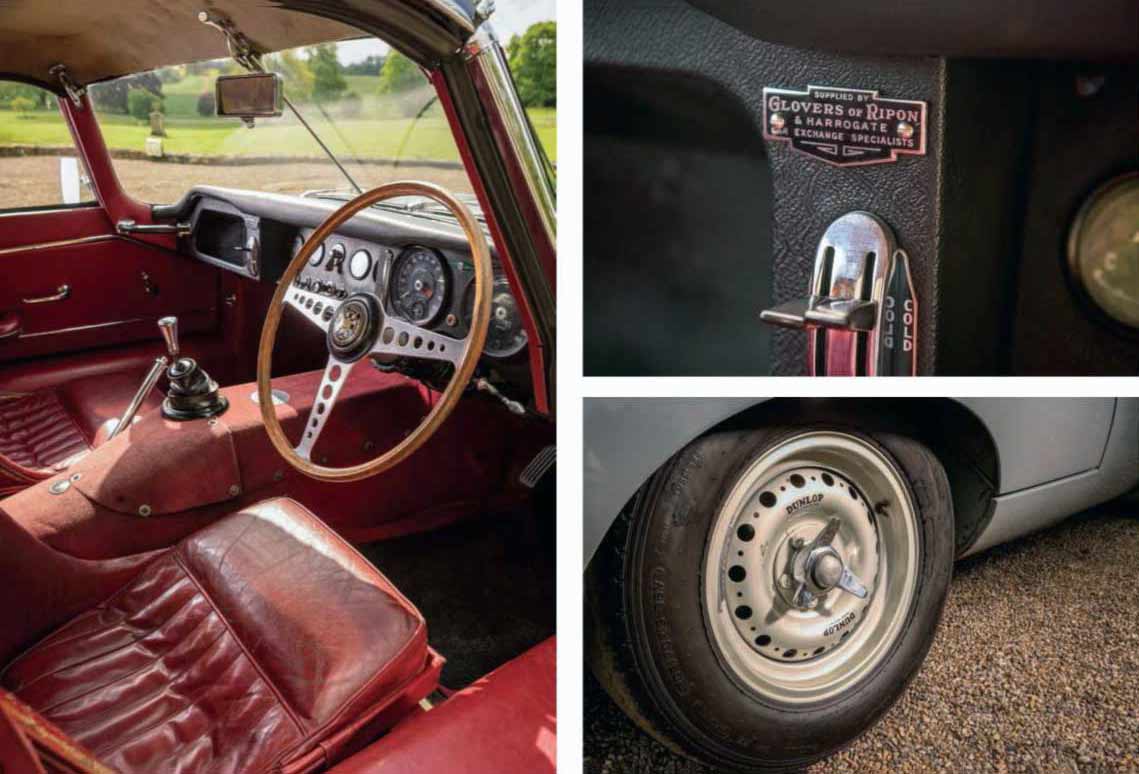
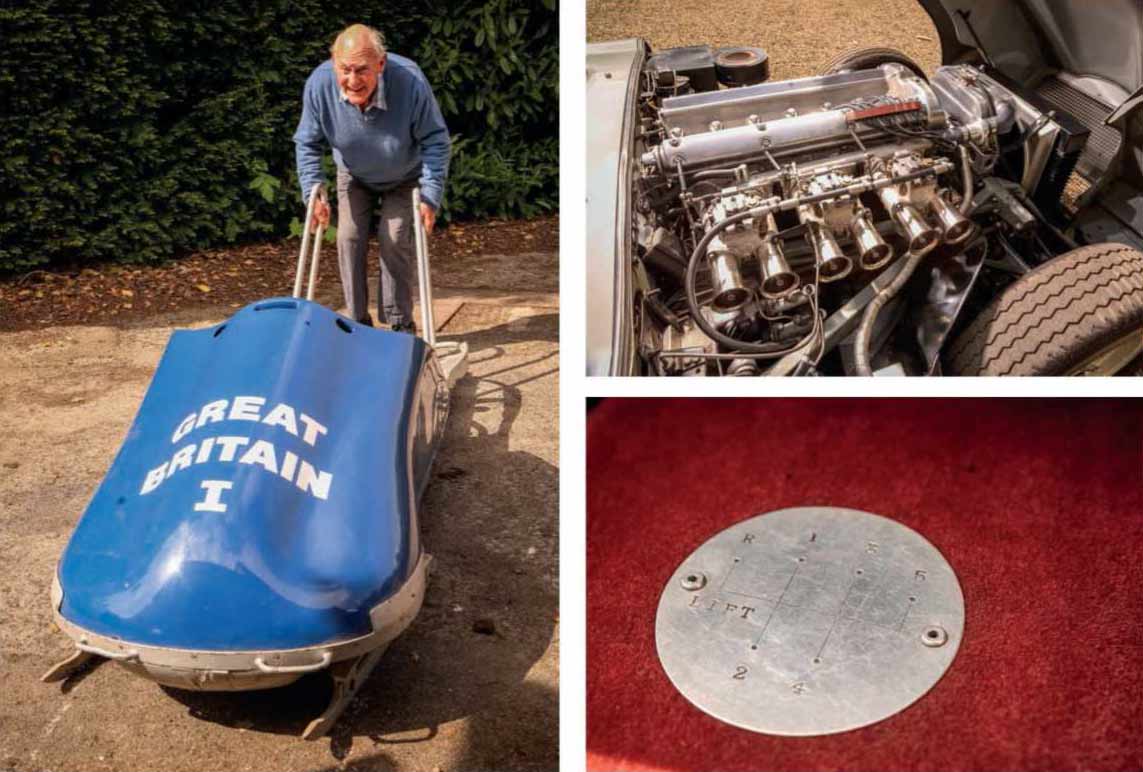

“It was a breathtaking road car and my father used it regularly to drive to the office in Darlington – before the speed limit he would see 130mph”
BRUCE ROPNER: MAN OF SPEED
In British bobsleigh history, 84-year-old Bruce Ropner is a legend and he was awarded an OBE for his services to the daring winter sport. For seven decades, this inspiring octogenarian has ridden the icy downhill runs, and even last year this grandfather experienced 75mph at Igls in Austria. “For pure speed nothing matches Horse Shoe Corner at St Moritz, where you pull 5G,” enthuses the former Welsh Guard. “My friend Keith Schellenberg introduced me to bobsleigh in 1958. ‘You’re a fit man Bruce, come and join us,’ he said. I thought about it for about three seconds.
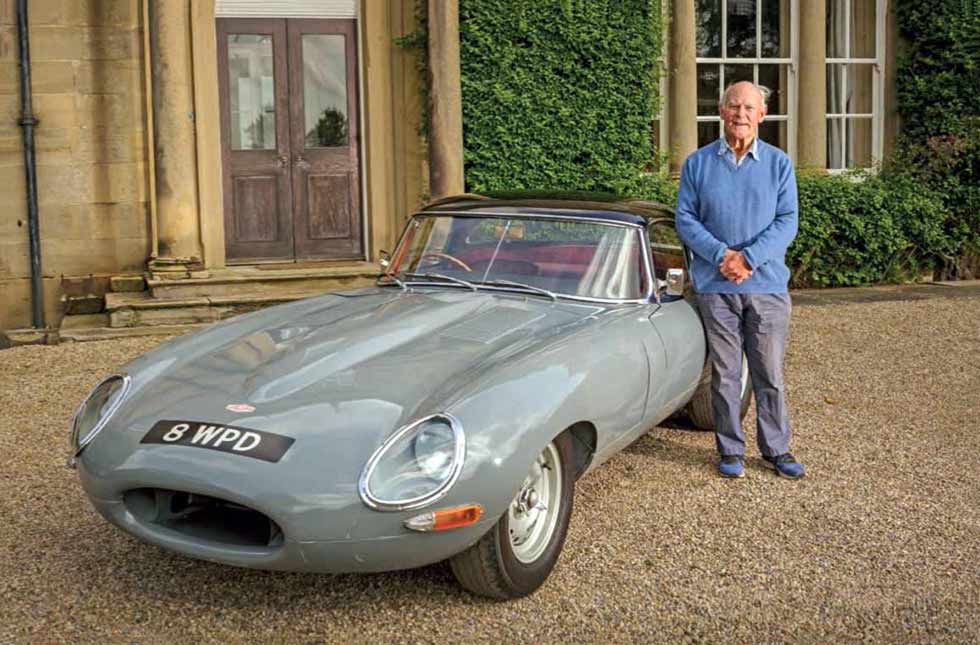
After the first run I looked like a ghost, but I never looked back.” Ropner competed with the British team from 1958 until ’1964, but continued as an amateur after he started a family. In later years, he built a dry run on the Camp Hill estate to encourage young enthusiasts – British Winter Olympians Nicola Minichiello and Mica McNeill owe much to his encouragement.
Speed has been a constant feature in Ropner’s life. With pal Schellenberg he co-owned the legendary Barnato-Hassan Brooklands Outer Circuit Bentley legend during the mid ’50s, which he ran on the road with two-seater bodywork and cycle wings. In later years he owned a Cobra 289, in which he regularly competed at hillclimbs, sprints and drag meetings: “It set some fantastic averages up the A1 and was once clocked at 164mph near Grantham. The Cobra was great fun.”
He also co-owned one of the first dragsters in the UK and, with British bobsleigh pioneer Norman Barclay, competed at early events including at Blackbushe and Croft. “We bought it in 1964 and called it ‘Dos Palmos’. Our first test run was at Graveley Airfield, where it did 150mph in 10 secs. The surface was very bumpy and the draught created a blizzard of fluff from the dandelions.”
The Ropner family was involved in establishing Croft as a racetrack in 1966, and the E-type regularly turned laps to test the circuit’s design, but was never raced. For the first meeting, a big-banger sports-car race was the feature that tempted John Surtees and Denny Hulme to enter: “John came up the day before for extra practice in his Lola T70 and took me for a few laps. I loved racing my father’s D-type at Croft.” In later years, Ropner helped save Mallory Park and co-owned the track with Chris Craft.
Over the years, Ropner has met some famous motor racing characters: “Jim Clark once stopped at our office in his Lotus. He was a very nice man and took me out in the pouring rain in his Elan. His reactions were fantastic.” Ecurie Ecosse mechanic Wilkie Wilkinson was also a family friend. “Wilkie regularly stayed at Camp Hill, and even helped tune my Cobra when working at BRM.” Classic Jaguars are still close to Ropner’s heart and today an XK150 is a prized vehicle: “It was our wedding car in 1960. I sold it once but missed it so much that I bought it back.”







